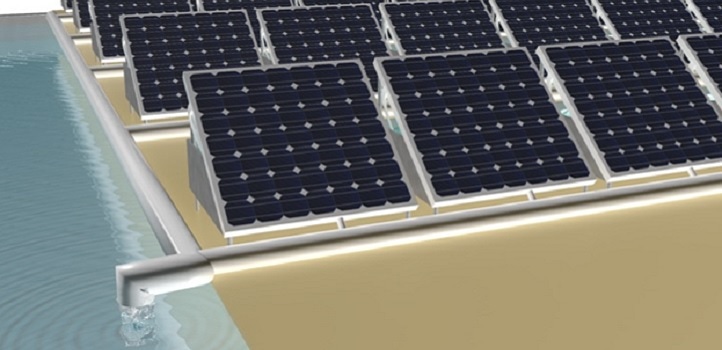Jul 11 2019
Scientists from KAUST have developed a multifunctional device that can capture the heat diffused by photovoltaic solar panels. It can be used to produce clean drinking water as a means to simultaneously produce water and electricity using only renewable energy.
 A solar farm of photovoltaic panels with a heat-driven seawater desalination system beneath each panel could cogenerate renewable electricity and fresh water in arid coastal areas. (Image credit: Wenbin Wang, 2019)
A solar farm of photovoltaic panels with a heat-driven seawater desalination system beneath each panel could cogenerate renewable electricity and fresh water in arid coastal areas. (Image credit: Wenbin Wang, 2019)
Wenbin Wang, a PhD student in Peng Wang’s laboratories at the Water Desalination and Reuse Center, KAUST, stated that there is a close connection between the production of both water and energy. In traditional solar farms, fresh water is used to remove dust from the panels. At the same time, water desalination plants expend more electricity to generate fresh water from seawater.
The water-energy nexus is one of the main issues threatening sustainable global development.
Wenbin Wang, PhD Student, Water Desalination and Reuse Center, KAUST
Professor Wang and his colleagues have designed a device that has the potential to solve this issue. Commercial PV panels can convert light energy from the sun into electricity with a maximum efficiency of 20%. The remaining 80% is dissipated, predominantly released as heat into the surrounding atmosphere. The researchers have created an integrated device that is capable of capturing this heat and using it to produce fresh water.
They constructed a device in which a stack of water channels, isolated by heat conduction layers and porous hydrophobic membranes, were attached to the bottom of a commercial PV panel. Waste heat from the panel evaporated seawater in the uppermost channel; the vapor passed over the porous membrane and condensed as fresh water in a clean water channel just underneath. During the condensation of the vapor, its heat passed through a heat conduction layer to the next seawater channel for recycling the energy to purify more water.
The device uses three stacked layers of water distillation channels and with drives the energy from layer to layer to produce about 1.64 L of water per square meter of solar panel surface each hour.
Wenbin remarked that such water output was more than twice that of conventional solar stills, which use a single-stage design. At the same time, the electricity output of the PV panel was not affected by the water desalination that occurs at its bottom.
Another advantage of the design is that water and electricity could be jointly produced on the same land, sharing a mounting system. Wenbin stated that the researchers are currently intending to incorporate agricultural production into the system.
According to Wenbin, “Raising sheep in the field of PV farms is feasible because grass grows well using the fresh water from solar-panel washing. A PV farm with sheep grazing while seawater is being desalinated using our device could be ideal in arid regions near the coast.”